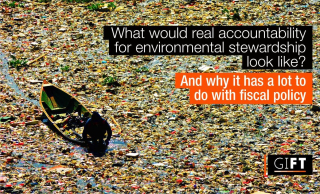
Posted by Murray Petrie[1]
In a previous PFM blog I discussed the urgent need for stronger mechanisms of environmental stewardship. This article discusses the closely related topic of ‘green budgeting’.
Green budgeting refers to use of the budgetary system to achieve improved environmental outcomes (OECD 2018). Some of the environmental impacts of fiscal policy are positive. Examples include funding for environmental protection, R&D spending on green technologies, environmental regulation, the collection, monitoring, reporting of environmental data, and research on how to conserve the environment.
Other environmental impacts of fiscal policies can be negative, such as those from fossil fuel and agriculture subsidies or subsidised water and electricity consumption. The OECD estimates that between 2010 and 2015 direct government expenditure on subsidies for fossil fuels amounted to US$373-617 billion annually across 76 major economies.
In contrast, the amount governments spend on biodiversity was only around one-tenth of that amount. Further, the tax system is an important tool to ‘correct’ prices for activities that generate negative externalities, e.g., carbon emissions and pollution. Yet World Bank estimates show that specific carbon taxes and emissions trading systems cover only about 15% of global emissions.
What is green budgeting? The OECD launched the Paris Collaborative on Green Budgeting in December 2017. The objective is to adapt conventional budgeting tools to help align national expenditure and revenue processes with climate and other environmental goals. This requires establishing clear connections between public finance and environmental impacts.
The OECD has identified several components of green budgeting that might be included in the annual budget documentation or a separate ‘Green Budget Statement’. These components include:
- The anticipated environmental impacts of existing spending and revenue policies and any new policies or measures being introduced in the budget. These policies include direct spending, grants, loans, guarantees and other contingent liabilities, taxes, resource royalties, other non-tax revenues, tax expenditures, and the fiscal opportunity cost of measures such as the non-auctioning of rights to pollute.
- An assessment of the use of the tax system to ‘price’ environmental externalities (including carbon emissions).
- A cross-country comparison of selected environmental benchmarks, e.g., progress toward achieving biodiversity targets; the volume of spending on environmental protection, resource management, and fossil fuel tax subsidies; and estimates of the effective carbon price.
The OECD also recommends periodic (less than annual) supplementary reports:
- A Green Budget Fiscal Sustainability Report incorporating estimated environmental impacts and long-term fiscal sustainability analysis;
- A Green Balance Sheet which reports on the value of a country’s environmental assets and liabilities as a supplement to its financial balance sheet.
In addition to these elements, consideration could be given to the publication of:
- An annual Green Performance Budget Report linking as feasible the programs/outputs funded in ministry budgets to high-level environmental outcome indicators and targets.
- The interactions between fiscal policies and environmental regulation in terms of environmental outcomes—for example, the adequacy of funding of environmental regulatory functions, the revenue potential of cap and trade schemes, ‘feebate’ approaches to reducing environmental externalities, and the fiscal and distributional impacts of greenhouse gas liabilities.
- As feasible, an assessment of environmental resilience, short- to medium-term risks around critical environmental outcomes, and threats to long term sustainability.
- A periodic monitoring and evaluation (M&E) stocktake of the efficiency and effectiveness of government interventions in achieving environmental objectives, and identification of research priorities. For example, Sweden publishes a four-yearly environmental M&E stock-take.
Technical work is underway to support better understanding of the impacts of fiscal policies on the environment, including the OECD’s Cost-Benefit Analysis and the Environment 2018, and a spreadsheet tool developed by the IMF. This tool incorporates domestic externalities from fuel use to help countries evaluate policy trade-offs and progress towards their Paris Agreement climate change mitigation pledges.
Some governments have started to integrate climate change and wider environmental sustainability analysis into the budget process:
- Norway‘s 2016 Budget contained a detailed section on Sustainable Development and Green Growth, including a discussion of the use of taxes to improve resource efficiency, the country’s performance on climate change, the state of ecosystems, and the management of renewable resources.
- France is introducing a comprehensive reporting structure for climate economic analysis in its annual budget documents and intends to add data on public and private expenditures aligned with environmental targets.
- Mexico has mapped a large share of government expenditures and related performance indicators to SDG targets.
- Prompted by the requirements for issuing Green Bonds, Ireland is identifying the amount of government spending dedicated to addressing climate change and intends to introduce assessments of the environmental impacts of public spending.
- The 2019 ‘Well-being Budget’ in New Zealand integrated a comprehensive set of social and environmental indicators and objectives into budget decision-making.
There are a host of opportunities to build on these developments. International organizations such as the World Bank, the IMF, the OECD, and international multi-stakeholder networks such as GIFT and the Open Government Partnership are starting to work on and promote the development and diffusion of common international norms and commitments on green budgeting. GIFT, as a multi-stakeholder network, is well-placed to promote a role for national CSOs in developing green budgets in their countries.
[1] Lead Technical Advisor, Global Initiative for Fiscal Transparency (GIFT).
Note: The posts on the IMF PFM Blog should not be reported as representing the views of the IMF. The views expressed are those of the authors and do not necessarily represent those of the IMF or IMF policy.







